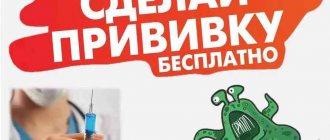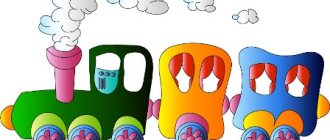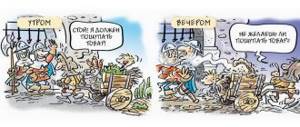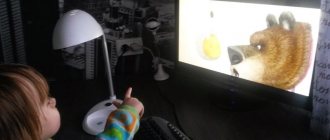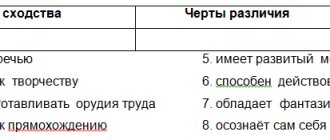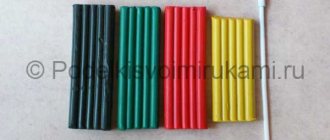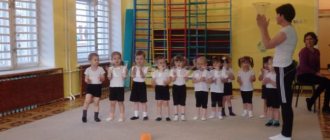FEMP classes. Junior group. September
Lesson 1
Program content
• Strengthen the ability to distinguish and name a ball (ball) and a cube (cube), regardless of the color and size of the figures.
Didactic visual material
Demonstration material. Large and small red balls, large and small green cubes; 2 boxes of red and green colors; toys: bear, truck.
Handout. Little red balls, little green cubes.
Guidelines
Part I. The teacher brings a truck into the group, in the back of which there is a bear, balls and cubes, and asks: “Who came to us? (Children look at the bear.) What did the bear bring in the truck?”
The teacher invites the children to find a ball (gives the concept of a ball): “What did you find? What color is the ball?
The teacher asks to show what can be done with the ball. (Ride.)
Children perform similar tasks with a cube. (Actions with a cube are indicated by the word put.)
Part II. Game exercise “Hide the cube (ball).”
The teacher invites one of the children to take a ball in one hand and a cube in the other and hide one of the figures behind their back. The rest of the children must guess what the child hid and what is left in his hand.
Part III . The teacher asks the children to help the bear put balls and cubes into boxes: the balls should be put in the red box, and the cubes in the green box.
While completing the task, the teacher asks the children: “What did you put in the box? How many balls (cubes)? Are they the same color? How else are balls and cubes different? (Big and small.)
Mishka thanks the children for their help and says goodbye to them.
Lesson 2
Program content
• Strengthen the ability to distinguish objects of contrasting size, using the words big and small.
Didactic visual material
Demonstration material. Large and small dolls, 2 beds of different sizes; 3 - 4 large cubes.
Handout. Small cubes (3 - 4 pieces for each child).
Guidelines
Part I. Two dolls come to visit the children. The children, together with the teacher, examine them, find out that one doll is large and the other small, and give them names.
Then the teacher draws the children’s attention to the cribs: “Are the cribs the same size? Show me the big crib. And now the little one. Where is the bed for a large doll, and where for a small one? Put the dolls to sleep. Let's sing them a lullaby “Tired toys sleep.”
Part II. Game exercise "Let's build turrets."
The teacher places large and small cubes on the table,
invites children to compare them in size and then build towers. The teacher builds a tower from large cubes on the carpet, and the children build towers from small cubes. At the end of the work, everyone looks at the buildings together and shows a large (small) tower.
FEMP classes. Junior group. November
Lesson 1
Program content
• Learn to compare two objects by length and denote the result of the comparison with the words long - short, longer - shorter.
• Improve the ability to compose a group of objects from individual objects and select one object from the group, denote aggregates with the words one, many, none.
Didactic visual material
Demonstration material. Two cardboard tracks of the same color but different lengths, two baskets with large and small balls.
Handout. Large and small balls (one ball for each child).
Guidelines
Game situation “We are funny guys.”
The lesson is held in the gym.
Part I. There are two cardboard tracks of different lengths on the floor.
The teacher asks the children what can be said about the length of the paths. Shows how this can be learned using overlays and track applications. Then he asks the children to show the long (short) path, walk along the long (short) path. Specifies the length of the tracks.
Part II . The teacher draws the children’s attention to the baskets with balls: “What can you say about the size of the balls? How many big balls? (A lot.) Take one large ball at a time. How many balls did each of you take? (One.) How many big balls are in the basket now? (None.) Let's try to roll the balls along a long track. How can we make sure there are a lot of balls in the basket again?” (Children's answers.)
Children put balls in a basket. The teacher clarifies how many balls each child put in the basket and how many there are.
Children perform a similar exercise with small balls. Children roll them along a short track, put them in a basket with large balls and answer the teacher’s questions: “How many small balls? (A lot.) How many big balls? (A lot.) How many big and small balls are there together? (Even more, a lot.)
Ill part. Outdoor game “Catch the ball”.
The teacher pours balls out of the basket and invites the children to catch up and take one ball at a time. (“How many balls did you catch?”) The children put the collected balls back into the basket, and the teacher finds out: “How many balls did you put in the basket? How many balls are in the basket?
The game is repeated several times.
Lesson 2
Program content
• Learn to find one and many objects in a specially created environment, answer the question “how many?” using the words one, many.
• Continue to teach how to compare two objects in length using the methods of superimposition and application, to indicate the results of comparison with the words long - short, longer - shorter.
Didactic visual material
Demonstration material. Four to five groups of toys, 2 boxes of different sizes, 2 ribbons of the same color of different lengths.
Handout. Ribbons of the same color, but of different lengths (2 pieces for each child).
Guidelines
Game situation “Toy Store”.
Part I. The teacher invites the children to visit the toy store. Toys are laid out on chairs and tables: one at a time and several at a time. Children, together with the teacher, look at the objects and find out what toys are sold in the store and how many there are. At the direction of the teacher, children “buy” one or many toys. The adult asks: “What toys did you buy? How many toys did you buy?
Part II. The teacher invites the children to choose ribbons for the toy boxes.
Children look at the boxes, and the teacher finds out: “How are the boxes different? Are the boxes the same size? Show the big (small) box. How can we bandage the boxes?”
The teacher asks to compare the ribbons: “What can you say about the length of the ribbons? How can you find out? How to compare ribbons by length? (By overlay or attachment.)
Children compare ribbons using the methods of application or application, show a long (short) ribbon, the results of the comparison are denoted by the words long - short, longer - shorter.
Children put ribbons in boxes: long ones in the big one, short ones in the small one.
Part III. Game exercise “Tie the boxes with ribbons.”
The teacher, together with the children, finds out what length of ribbon can be used to tie a large (small) box. First, they compare the ribbons by length, find the long (short) ribbon and tie the boxes.
Lesson 3
Program content
• Continue to teach how to find one and many objects in a specially created environment, to designate collections with the words one, many.
• Introduce the square, teach to distinguish between a circle and a square.
Didactic visual material
Demonstration material. “Parcel” with toys (cars, nesting dolls, pyramid, ball); a square and a circle of the same color (the length of the sides of the square and the diameter of the circle are 14 cm).
Handout. Circles and squares of the same color (the length of the sides of the square and the diameter of the circle are 8 cm).
Guidelines
Game situation “The postman brought a parcel.”
Part I. The teacher tells the children that the postman brought them a package. The teacher invites the children to see what they have been sent. He takes toys out of the box one by one, asks the children to name them, finds out the number of objects: “How many pyramids did they send us? How many cars (matryoshka dolls, balls) are in the package? What toys were sent to us a lot? What kind of toys, one at a time?
Part II . The teacher takes a circle out of the package and puts it on the flannelgraph: “What figure is this? (Circle.) What color is the circle?” The teacher invites the children to trace a circle along the contour with their hand.
Then he takes out a square, places it next to the circle, names the figure, shows the sides and corners of the square and asks the children: “What does a square have? How many sides does a square have? How many angles does a square have?
The teacher asks the children to circle the square and show its sides (corners).
Part III. Game exercise “Show and ride”.
The children have circles and squares on their tables. The teacher invites the children to take a circle, name the figure and trace it with their hand.
Similar actions are performed with a square.
Then the teacher asks the children to try to roll a circle around the table, and then a square, and finds out: “Can I roll a square? What’s stopping the square?” (Angles.)
Lesson 4
Program content
• To consolidate the ability to find one or many objects in a specially created environment, to denote aggregates with the words one, many.
• Continue to learn to distinguish and name a circle and a square.
Didactic visual material
Demonstration material. The group setting is used - a play corner (dolls, chairs, cups, etc.; table, bear, teapot, etc.), a natural corner (plants, aquarium, watering can, cage, etc.), a book corner ( books, pictures; shelf, book stand, etc.); garage (several small cars, one large car); silhouette of a steam locomotive, sheets of colored paper (cars).
Handout. Circles and squares of the same color (side length of the square is 8 cm, circle diameter is 8 cm; one for each child).
Guidelines
Part I. Children travel in a group to the music “Blue Car” (music and lyrics by V. Ya. Shainsky). First stop is the doll corner.
Educator. What's in the doll corner? What kind of toys are there a lot? Of which toys only one?
Then the children stop in a book corner, a nature corner, a garage and answer similar questions from the teacher.
Part II . Didactic game "Fix the train."
Circles and squares are laid out on the table. The teacher asks the children to find the circles and finds out: “What color are the circles? What can you do with them? (Ride.)
Then, on the instructions of the teacher, the children find squares, name the shapes and try to roll them on the table. The teacher reminds that the corners interfere with the square and asks the children to show them.
At the end of the lesson, the children “fix” the train, commenting on their actions: they put circles instead of wheels, squares instead of windows.
Summary of the book by I. Pomoraeva and V. Pozina
The book is a summary and curriculum for teachers of children 3-4 years old, distributed over the entire school year, which involves 1 lesson per week. The authors took into account the inevitable period of adaptation of each child after entering kindergarten, so the first lesson, according to the plan, is held after September 15.
FEMP in the 2nd junior group
Plan for the autumn period
The main directions of classes in the first quarter of the educational year, according to the book co-authored with Pozina, are focused on:
- Introduce two geometric shapes: circle and square. In the first lesson, children study a circle, its shape features, after which they move on to its volumetric analogue - a ball. Later, a square shape is added with a transition to a cube. The result of the study is the unmistakable choice of a circle and a square among other figures, as well as their comparison according to the main parameters.
- Clarification of quantitative concepts of objects, such as “one”, “none”, “many”. At the very beginning, children learn to define two quantities: “one” and “many”; after which the value “none” is added, which children should be able to use when the teacher asks the question “how many objects?”
- Consolidation of comparative skills, first limited to such concepts as “big” and “small”, after which additional elements of paired comparison are introduced, answering questions about which object is larger and which is smaller. The concept of length is also consolidated, starting with the statement “long” and “short”, and ending with comparisons - “longer”, “shorter”.
Defining a square among other shapes
Winter plan
In the second quarter, according to Pomoraeva’s FEMP notes, the 2nd junior group should study:
- The meanings of the words “evenly” and “many” in relation to the compared groups of objects. By the end of the second quarter, children should operate with additional meanings “little” - “many”.
- Orientation in your body, in relation to the right and left sides. The study begins with the hands and continues with other paired parts of the body.
- In classes on comparing objects, concepts such as “wide”, “narrow”, as well as “wider” - “narrower”, “equal in width” are added.
- A new geometric figure - a triangle. After analyzing its features, children learn to compare it with a square and name its distinctive features.
- Spatial arrangements of objects using the meanings “above” and “below”. After mastering these concepts, an analysis of the sizes of figures is added according to the criterion of “above”, “below”, “high”, “low”.
Where are there more carrots and where are there fewer?
Plan for the spring period
The summary continues the description of FEMP classes, 2nd junior group - Pomoraeva recommends:
- Introduce the concept of time of day. The formation of classes begins with an introduction to the contrasting concepts of “children” and “night”, later they teach “morning” and “evening”.
- Compare not only the visual number of objects, but also determine the number of sounds by ear, limiting oneself to two concepts “one” and “many”. After consolidating this skill, they begin to reproduce the number of sounds heard, but the numeral is not called, the children only hear the sequence of sounds, after which they try to repeat the combination.
- Improve spatial skills, to which the following definitions are added: “in front”, “behind”, “left”, “right”, “above” and “below”.
Non-traditional drawing technique for the middle group of kindergarten
Important! Each subsequent task not only introduces novelty and introduces terms. It is recommended to build mathematical classes on the basis of consolidating previous material. Therefore, before introducing new concepts, the teacher must consolidate previously covered material in each lesson.
